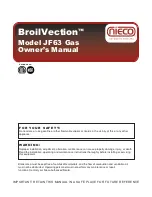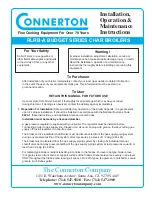
14
221462C
6 Commissioning
6.7 Adjustment - Sealed Water Systems
Sealed water systems should be adjusted to the initial design
pressure and the set pointer repositioned.
6.8 Instruct the User in the Correct Operation
of the Boiler
Hand the User Instructions to the user for their use.
Instruct and demonstrate the safe and efficient operation of the
boiler, heating system and domestic hot water system.
Advise the user, that to ensure the continued efficient and safe
operation of the boiler it is recommended that it is checked and
serviced at regular intervals. The frequency of servicing will
depend upon the particular installation and usage, but in general
once a year should be enough.
It is the Law that servicing is carried out by a competent person.
Draw attention, if applicable, to the current issue of the Gas
Safety (Installation and Use) Regulations section 35, which
imposes a duty of care on all persons who let out any property
containing a gas appliance.
Advise that the boiler is fitted with a safety device and refer to
the instructions for use.
Advise the user of the precautions necessary to prevent damage
to the system and building in the event of the heating system
being out of use during frost and freezing conditions.
Reminder. Leave these instructions with the user.
Advise the user that the ‘Benchmark’ logbook should be
completed by the installation engineer on completion of
commissioning or servicing.
For the continued efficient and safe operation of the boiler it is
recommended that it is checked and serviced at regular intervals.
The frequency will depend upon the particular installation and
usage, but in general once a year should be enough.
It is the Law that any servicing be carried out by a competent
person.
Replacement of parts must be carried out by a competent
person.
Before starting a service or replacing parts isolate the gas and
electrical supplies.
Unless stated otherwise all parts are replaced in the reverse
order to removal.
7.1 Heating Body - Service
Remove the controls cover by pulling it forwards and off.
Remove the outer casing by releasing the screw at the bottom
and unhooking at the top.
Remove the inner casing by releasing the wing nuts at the top
and the screws at the bottom, see diagram 7.1.
Remove the combustion chamber front by unscrewing the wing
nut at the bottom front and the four screws, see diagram 7.2.
Disconnect the ignition lead from the electrode and unscrew
thermocouple nut to release, see diagram 7.3.
Support the main burner and release pilot tubing nut at the base
of burner, release pilot tube. The pilot injector can now be
removed by unscrewing, see diagram 7.3.
Disengage the main burner from the main injector. Raise the
burner up through the combustion chamber to remove. Take
care not to damage the side insulation.
Place the burner to one side.
Cover the combustion chamber and injector with a sheet of
paper.
Remove the flue cleaning door, see diagram 7.1.
Remove the screws securing the draught diverter baffle and
lower out as shown in diagram 7.4.
Brush away any deposits from the heat exchanger paying
particular attention to the gap between the fins.
Remove the paper together with any debris.
When replacing parts make sure that the draught diverter is
refitted correctly.
Diagram 7.1
ACCESS FOR SERVICING
FLUE CLEANING DOOR
INNER
CASE
INNER CASING
SECURING
SCREWS
WING
NUT(S)
2398
7.2 Main Burner - Service
Generally follow the instructions given in Section 7.1.
With the main burner removed brush or vacuum any deposits
away, make sure that the flame ports are clear.
Do not use a brush with metallic bristles.
Note. Alternative type of burner are fitted to some models.
Remove lint arrester from main burner and clean it thoroughly
by brushing or vacuuming, see diagram 7.5 for Bray burner and
diagram 7.6 for Furigas burner.
7 Servicing and Replacement of Parts










































